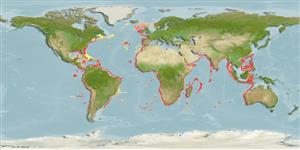Common names from other countries
>
Gadiformes (Cods) >
Macrouridae (Grenadiers or rattails)
Etymology: Malacocephalus: Greek, malakos = soft + Greek, kephale = head (Ref. 45335).
More on author: Lowe.
Environment: milieu / climate zone / depth range / distribution range
นิเวศวิทยา
เกี่ยวกับทะเล,น้ำเค็ม สัตว์หน้าดินในเขตน้ำลึก; ไม่มีการอพยพย้ายถิ่น; ระดับความลึก 200 - 1000 m (Ref. 1371), usually 300 - 750 m (Ref. 3587). Deep-water; 62°N - 43°S, 97°W - 124°E (Ref. 1371)
Atlantic, Indian and Pacific: Western Atlantic: Strait of Florida to Brazil, Gulf of Mexico and Caribbean Sea. Eastern Atlantic: Iceland (Ref. 12462) and Faroes to South Africa. Indian Ocean: Arabian Sea, Bay of Bengal, off Maldives and off East African coast. Western Pacific: Indonesian area and Australia. Eastern Central Pacific (Ref. 9315). Malacocephalus hawaiiensis, Malacocephalus luzonensis, and Malacocephalus nipponensis are closely related to Malacocephalus laevis and may eventually prove to represent populations of this species, if a comprehensive comparison of material from the Atlantic, Indian and Pacific oceans is done (Ref. 1371).
ขนาด / น้ำหนัก / Age
Maturity: Lm ? range ? - ? cm
Max length : 60.0 cm TL เพศผู้/กระเทย; (Ref. 2800); common length : 40.0 cm TL เพศผู้/กระเทย; (Ref. 26999)
เงี่ยงครีบหลัง (รวม) : 2; ก้านครีบอ่อนที่หาง (รวม) : 229; เงี่ยงครีบก้น: 0. Head uniformly scaled, including the mandibles and the ventral aspects of the snout and suborbital. Snout blunt, its tip with a conical tubercle. The trunk is short, the body tapers abruptly from behind the first dorsal fin. The caudal fin is absent.
Found on continental slopes (Ref. 1371). Utilized mainly for fishmeal and oil (Ref. 1371). In the past, fishers in the North Atlantic were reported to have used the luminescent excretion from the ventral light organ to enhance baits used for cod fishing (Ref. 1371).
Life cycle and mating behavior
Maturities | การสืบพันธุ์ | Spawnings | Egg(s) | Fecundities | ตัวอ่อน
Cohen, D.M., T. Inada, T. Iwamoto and N. Scialabba, 1990. FAO species catalogue. Vol. 10. Gadiform fishes of the world (Order Gadiformes). An annotated and illustrated catalogue of cods, hakes, grenadiers and other gadiform fishes known to date. FAO Fish. Synop. 125(10). Rome: FAO. 442 p. (Ref. 1371)
IUCN Red List Status (Ref. 130435)
CITES (Ref. 128078)
Not Evaluated
Threat to humans
Harmless
Human uses
การประมง: มีการค้าเพียงเล็กน้อย
เครื่องมือ
Special reports
Download XML
แหล่งที่มาจากอินเตอร์เน็ต
Estimates based on models
Preferred temperature (Ref.
115969): 6.1 - 13.9, mean 9.5 (based on 824 cells).
Phylogenetic diversity index (Ref.
82804): PD
50 = 0.5078 [Uniqueness, from 0.5 = low to 2.0 = high].
Bayesian length-weight: a=0.00129 (0.00075 - 0.00222), b=3.14 (2.99 - 3.29), in cm Total Length, based on LWR estimates for this species & (Sub)family-body (Ref.
93245).
ระดับชั้นอาหาร (Ref.
69278): 3.8 ±0.56 se; based on food items.
ความสามารถในการกลับคืนสู่ปกติ (Ref.
120179): ต่ำมาก, เวลาต่ำสุดที่จะทำให้ประชากรเพิ่มขึ้นเป็น 2 เท่าใช้เวลามากกว่า 14 ปี (Preliminary K or Fecundity.).
Fishing Vulnerability (Ref.
59153): Moderate vulnerability (44 of 100).
